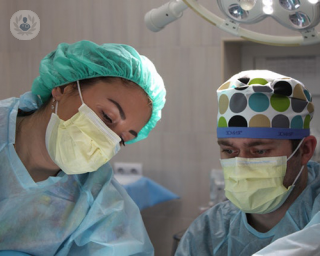What is achalasia?
Achalasia is a rare disorder that effects the oesophagus (food pipe), making it very difficult to swallow food and drink and for it to pass into the stomach. This happens when the ring of muscle at the end of the oesophagus does not open fully, if at all. As a result, food and drink cannot be squeezed down into the stomach and gets stuck, and is often regurgitated.

What are the symptoms of achalasia?
Not everyone with this disorder has symptoms, but those who do can experience:
- Regurgitating undigested food
- Chest pains
- Coughing fits
- Heartburn
- Excessive saliva and drooling
- Gradual weight loss
The onset of achalasia can happen at any point in your life and if left untreated, the chances of oesophageal cancer developing are increased. If you experience any of these symptoms, it is important to see the right specialist so that a diagnosis can be made, and a treatment plan put in place.
What causes achalasia?
The cause of achalasia is largely unknown, however, it is thought to occur when nerves in the oesophagus are damaged and cease to work fully, causing the ring of muscle at the end of the oesophagus to stop working. The cause of this nerve damage is not known, but could be linked to infection, or possibly autoimmune conditions. There is also some possibility that achalasia is hereditary and runs in families.
How is achalasia diagnosed?
Diagnosis of achalasia can be difficult as it shares symptoms with other digestive disorders. If your specialist suspects you have achalasia, the following tests are likely to be carried out:
- Manometry – a small tube is inserted into the nose or mouth into the oesophagus to measure for muscle contractions when you swallow and to detect any pressure that builds up.
- Endoscopy – an endoscope passes down the throat so that the oesophageal lining can be examined, and can identify any blockages that may be present.
- X-rays – here the patient swallows a liquid containing barium, and then x-rayed. This procedure highlights how much time it takes for the liquid to pass into your stomach.
What is the treatment for achalasia?
Although there is no current cure for achalasia, there are certainly measures to alleviate the symptoms. The key to successful treatment is to make it easier for the patient to swallow when eating and drinking. Certain medicines are designed to relax the oesophageal muscles, making it easier to swallow, however, the effects are only temporary.
Other treatment options include:
- Botox injections – injected into the ring of muscle that allows food into the stomach as the botox causes it to relax.
- Surgery – via keyhole surgery (laparoscopy), the ring of muscle is cut and can permanently make it easier to swallow.
- Dilating the muscle – a balloon is passed down the oesophagus to help stretch out the ring of muscle that lets food into the stomach, which makes swallowing easier and less painful.
Achalasia
What is achalasia?
Achalasia is a rare disorder that effects the oesophagus (food pipe), making it very difficult to swallow food and drink and for it to pass into the stomach. This happens when the ring of muscle at the end of the oesophagus does not open fully, if at all. As a result, food and drink cannot be squeezed down into the stomach and gets stuck, and is often regurgitated.

What are the symptoms of achalasia?
Not everyone with this disorder has symptoms, but those who do can experience:
- Regurgitating undigested food
- Chest pains
- Coughing fits
- Heartburn
- Excessive saliva and drooling
- Gradual weight loss
The onset of achalasia can happen at any point in your life and if left untreated, the chances of oesophageal cancer developing are increased. If you experience any of these symptoms, it is important to see the right specialist so that a diagnosis can be made, and a treatment plan put in place.
What causes achalasia?
The cause of achalasia is largely unknown, however, it is thought to occur when nerves in the oesophagus are damaged and cease to work fully, causing the ring of muscle at the end of the oesophagus to stop working. The cause of this nerve damage is not known, but could be linked to infection, or possibly autoimmune conditions. There is also some possibility that achalasia is hereditary and runs in families.
How is achalasia diagnosed?
Diagnosis of achalasia can be difficult as it shares symptoms with other digestive disorders. If your specialist suspects you have achalasia, the following tests are likely to be carried out:
- Manometry – a small tube is inserted into the nose or mouth into the oesophagus to measure for muscle contractions when you swallow and to detect any pressure that builds up.
- Endoscopy – an endoscope passes down the throat so that the oesophageal lining can be examined, and can identify any blockages that may be present.
- X-rays – here the patient swallows a liquid containing barium, and then x-rayed. This procedure highlights how much time it takes for the liquid to pass into your stomach.
What is the treatment for achalasia?
Although there is no current cure for achalasia, there are certainly measures to alleviate the symptoms. The key to successful treatment is to make it easier for the patient to swallow when eating and drinking. Certain medicines are designed to relax the oesophageal muscles, making it easier to swallow, however, the effects are only temporary.
Other treatment options include:
- Botox injections – injected into the ring of muscle that allows food into the stomach as the botox causes it to relax.
- Surgery – via keyhole surgery (laparoscopy), the ring of muscle is cut and can permanently make it easier to swallow.
- Dilating the muscle – a balloon is passed down the oesophagus to help stretch out the ring of muscle that lets food into the stomach, which makes swallowing easier and less painful.


How is achalasia diagnosed and treated?
By Dr Rami Sweis
2024-11-19
If you've recently found that you're finding it difficult to pass food, even after drinking water, it may be a case of achalasia. Find out how you can get tested for this condition, what all the symptoms are how it is treated. Dr Rami Sweis, a leading consultant gastroenterologist, explains everything you need to know about this condition in this latest article. See more


An expert guide to POEM treatment for achalasia
By Mr Amyn Haji
2024-11-18
Achalasia, an unusual conditon where food cannot pass easily from the food pipe to the stomach, often requires surgical treatment. Peroral endoscopic myotomy (POEM) is a minimally-invasive, surgical procedure used to fcailitate the passage of food. We invited highly respcted consultant colorectal and general surgeon Mr Amyn Haji to explain how the procedure is performed and the risks and advantages it offers patients. See more


Achalasia: a possible reason behind swallowing problems
By Professor Muntzer Mughal
2024-11-14
If you're having difficulty in swallowing both drinks and solid foods, then you may be experiencing achalasia, a rare condition that is often overlooked. Read more from our expert surgeon Professor Muntzer Mughal on the causes, symptoms and treatment options. See more
Experts in Achalasia
-
Mr Majid Hashemi
SurgeryExpert in:
- Achalasia
- Gastric sleeve
- Acid reflux
- Hiatal hernia
- Gastric bypass
- Obesity surgery
-
Mr Amyn Haji
Colorectal surgeryExpert in:
- Colorectal cancer
- Polyps
- Endoscopy
- Hernia
- Piles (haemorrhoids)
- Achalasia
-
Dr Rami Sweis
GastroenterologyExpert in:
- Difficult Swallowing (Dysphagia)
- Gastrointestinal endoscopy
- Constipation
- Diarrhoea
- Barrett's oesophagus
- Achalasia
-
Mr Nagammapudur Balaji
SurgeryExpert in:
- Achalasia
- Acid reflux
- Laparoscopic hernia surgery
- Bariatric surgery
- Gallbladder surgery
- Hiatal hernia surgery
-
Professor Nick Maynard
SurgeryExpert in:
- Gastroscopy
- Upper GI surgery
- Hiatal hernia surgery
- Achalasia
- Cholecystectomy
- See all

The Harborne Hospital - part of HCA Healthcare
The Harborne Hospital - part of HCA Healthcare
Mindelsohn Way, B15 2FQ
No existe teléfono en el centro.
By using the telephone number provided by TOP DOCTORS, you automatically agree to let us use your phone number for statistical and commercial purposes. For further information, read our Privacy Policy
Top Doctors

The Duchy Hospital - part of Circle Health Group
The Duchy Hospital - part of Circle Health Group
Queen's Road, Harrogate HG2 0HF
No existe teléfono en el centro.
By using the telephone number provided by TOP DOCTORS, you automatically agree to let us use your phone number for statistical and commercial purposes. For further information, read our Privacy Policy
Top Doctors

The Park Hospital - part of Circle Health Group
The Park Hospital - part of Circle Health Group
Sherwood Lodge Drive, Burntstump Country Park, Arnold, Nottinghamshire NG5 8RX
No existe teléfono en el centro.
By using the telephone number provided by TOP DOCTORS, you automatically agree to let us use your phone number for statistical and commercial purposes. For further information, read our Privacy Policy
Top Doctors
-
The Harborne Hospital - part of HCA Healthcare
Mindelsohn Way, B15 2FQ, BirminghamExpert in:
- Digestive
- Cancer
- Orthopaedic surgery
- Thoracic Surgery
- Diagnostic Imaging
- Obstetrics and Gynaecology
-
The Duchy Hospital - part of Circle Health Group
Queen's Road, Harrogate HG2 0HF, HarrogateExpert in:
- Cardiology
- General Surgery
- Plastic surgery, reconstructive and aesthetics
- Diagnostic Imaging
- Ophthalmology
- Otolaryngology
-
The Park Hospital - part of Circle Health Group
Sherwood Lodge Drive, Burntstump Country Park, Arnold, Nottinghamshire NG5 8RX, ArnoldExpert in:
- General Surgery
- Maxillofacial Surgery
- Oral surgery
- Plastic surgery, reconstructive and aesthetics
- Obstetrics and Gynaecology
- Podiatry
- See all
- Most viewed diseases, medical tests, and treatments
- Migraine
- Nutrition
- Weight loss injections
- Nipple discharge
- Abdominal pain
- Endovenous laser treatment (EVLA)
- Minimal access surgery (keyhole surgery)
- Head and neck cancer
- Neck lump
- Bariatric surgery








